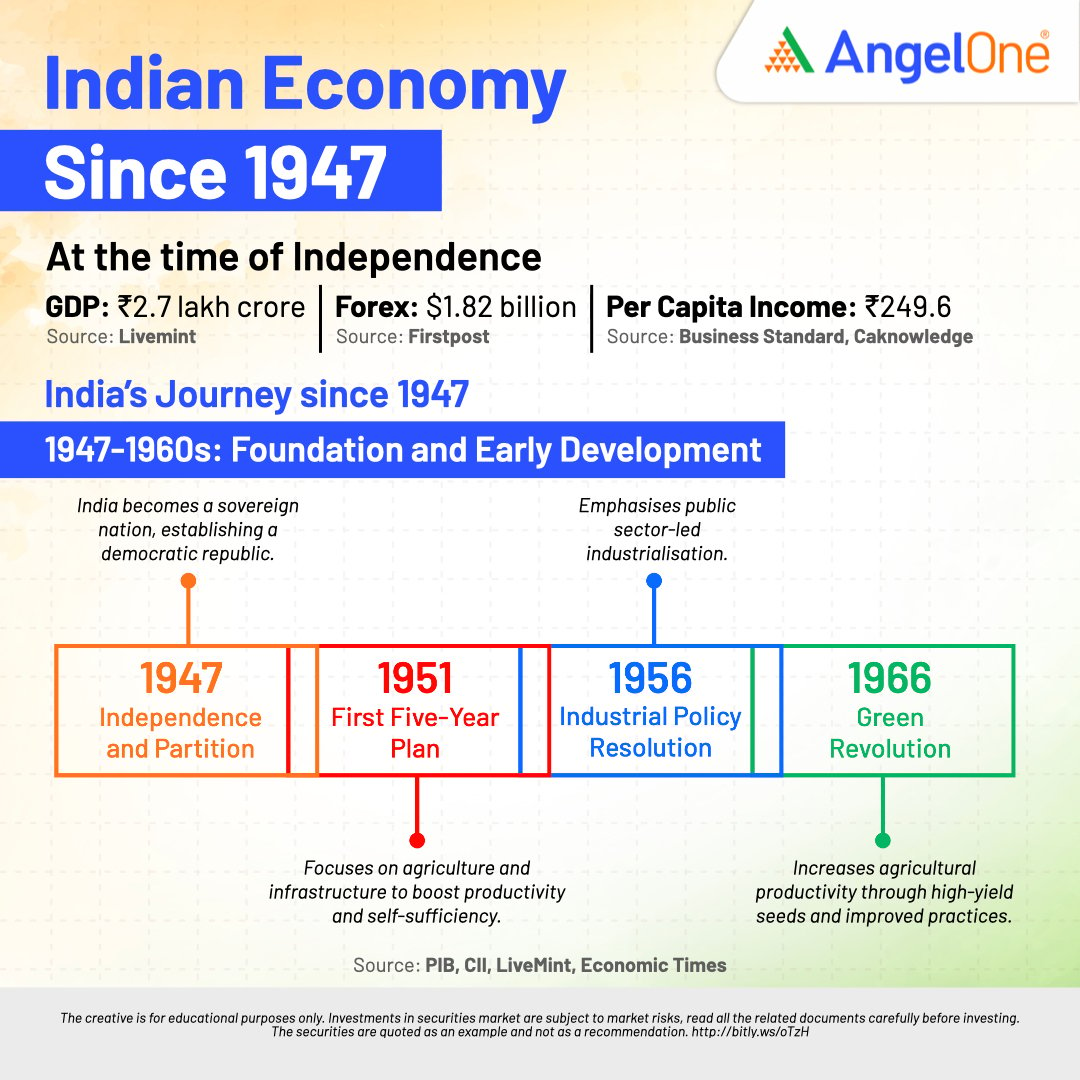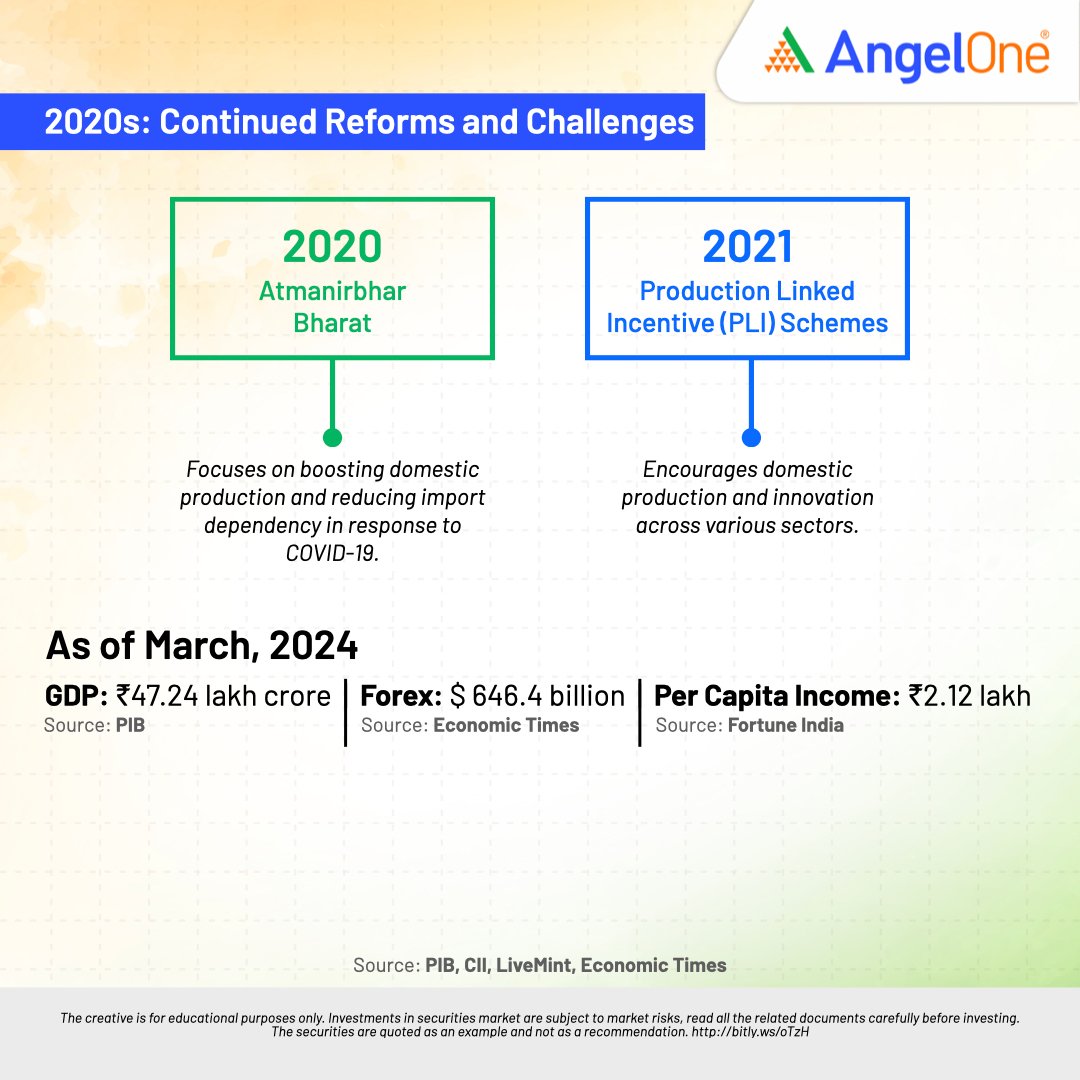
Since gaining independence in 1947, India has undergone significant economic transformation. This journey from a primarily agricultural economy to a global player in various sectors has been marked by numerous key events and policy changes. Let’s delve into the statistical milestones that have shaped India’s economic landscape over the decades.
At the time of independence, agriculture contributed about 50% of India’s GDP and employed nearly 70% of the workforce. The focus was on achieving self-sufficiency in food production.
The Industrial Policy Resolution of 1956 laid the foundation for the mixed economy model, emphasising the importance of the public sector in driving industrial growth. By 1980, agriculture’s contribution to GDP had declined to about 35%, while the industrial sector’s contribution had increased to 25%.

The Green Revolution, initiated in the 1960s, transformed India’s agriculture sector. High-yielding variety (HYV) seeds, chemical fertilisers, and advanced irrigation techniques were introduced. By 1970, wheat production had increased from 10.4 million tonnes in 1960 to 20 million tonnes.
The Green Revolution ensured food security and reduced India’s dependence on food imports. By the late 1970s, India became self-sufficient in food grains.
In 1969, the government nationalised 14 major commercial banks, controlling 70% of the banking sector’s deposits. This move aimed to ensure sufficient credit for agriculture, small industries, and exports. By 1980, another six banks were nationalised.
The nationalisation led to a significant expansion in bank branches and credit availability. The number of bank branches increased from 8,262 in 1969 to 62,000 in 1980.
In 1991, India faced a severe balance of payments crisis. The government, led by then Prime Minister P.V. Narasimha Rao and Finance Minister Dr Manmohan Singh, introduced economic reforms known as LPG.
Post-liberalisation, India’s GDP growth rate increased from an average of 3.5% (1950-1980) to over 6% in the 1990s. By 2000, India’s GDP stood at $476 billion, up from $275 billion in 1991.
The IT sector became a major growth driver. India’s IT exports grew from $565 million in 1991 to $59 billion in 2010. By 2020, the IT sector contributed approximately 7.7% to India’s GDP. The IT sector growth has been fueled by some major giants like TCS, Infosys, HCL, Wipro and others. TCS was listed on stock exchanges in 2004 with an issue price of ₹850, and the stock has surged to ₹4,200 as of August 07, 2024. In addition, the growth of the sector has also been pushed by companies like Infosys, Wipro and HCL with the delivery of various IT solutions like significant software and AI development.
By 2020, the IT and IT-enabled services (ITES) sector employed over 4 million people directly and 10 million indirectly.
India has made significant strides in defence production. Defence exports increased from $213 million in 2014 to $1.5 billion in 2020. The sector aims to achieve $5 billion in defence exports by 2025. Major companies like Bharat Electronics Ltd, Hindustan Aeronautics Limited, Bharat Dynamics Limited have delivered a 5Y CAGR of 56.15%, 71.21% and 57.57%, respectively and backed the sectors’ growth.
Notable projects include the development of the Tejas fighter aircraft, the BrahMos missile, and the Arihant-class nuclear submarines.
The Goods and Services Tax (GST), implemented in 2017, replaced a multitude of indirect taxes with a single tax structure. This reform aimed to create a unified national market, improving the ease of doing business.

India’s GDP reached $2.87 trillion in 2019, making it the 5th-largest economy in the world. Despite the challenges posed by the COVID-19 pandemic, the economy is projected to grow at a robust pace, aiming to reach a $5 trillion economy by 2025.
India’s digital economy has expanded rapidly, with internet users growing from 34 million in 2001 to over 750 million in 2020. Initiatives like Digital India aim to transform India into a digitally empowered society and knowledge economy.
India’s economic progress since 1947 is a testament to its resilience and adaptability. From an agrarian economy to a diversified global player, India’s journey is marked by significant reforms, policy changes, and sectoral growth. As the country continues to innovate and adapt, the future holds promising prospects for further economic development.
Disclaimer: This blog has been written exclusively for educational purposes. The securities mentioned are only examples and not recommendations. It is based on several secondary sources on the internet and is subject to changes. Please consult an expert before making related decisions.
Published on: Aug 13, 2024, 3:29 PM IST
We're Live on WhatsApp! Join our channel for market insights & updates